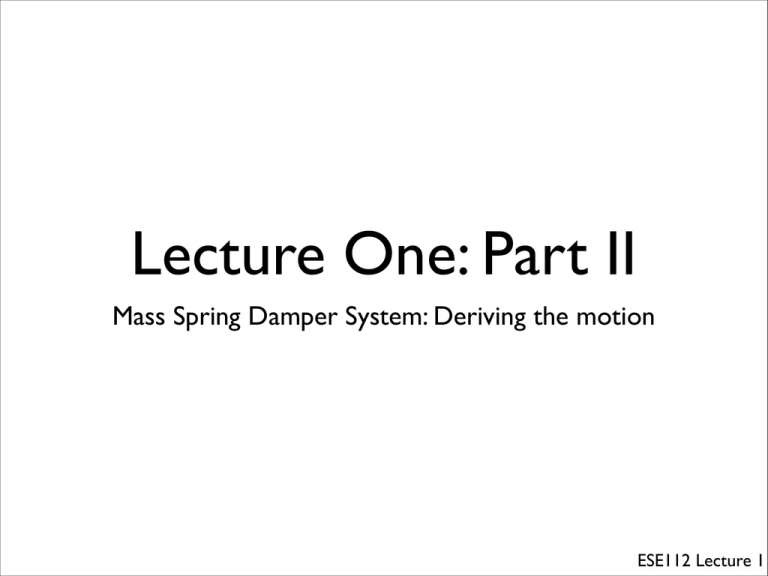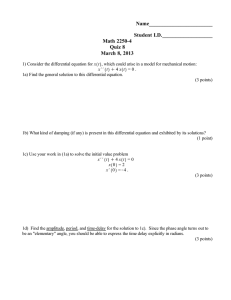Mass Spring Damper System: Deriving the motion
advertisement

Lecture One: Part II Mass Spring Damper System: Deriving the motion ESE112 Lecture 1 MSD Review Created by Wikipedia user lzyvzl Mass (m) is attached to Hook’s law spring Recall Fs = −kx Damping Force Fd = c dx dt ESE112 Lecture 1 Deriving Equations of Motion From Newton ! rearranging f = ma (1) mẍ = −cẋ − kx (2) mẍ + cẋ + kx = 0 (3) c k ẍ + ẋ + x m m (4) dividing by m " k , be the natural frequency of the system and ζ = if we let ω0 = m the damping ratio, we get ẍ + 2ζω0 ẋ + ω02 x = 0 √c , 2 km be (5) http://en.wikipedia.org/wiki/Damping ESE112 Lecture 1 Solving the differential equation What’s a differential equation? “A differential equation is a mathematical equation for an unknown function of one or several variables that relates the values of the function itself and of its derivatives of various orders.” A simple instantiation of this is an equation which relates the velocity, dx/dt, of an object as a function of it’s position F(x) in time. ESE112 Lecture 1 Solution for a special case ESE112 Lecture 1 Solution for a special case Recall from calculus that if y = eax (1) then dy = aex dx Now we can try to solve a simple differential equation dx =x dt (2) (3) ESE112 Lecture 1 Solution for a special case Recall from calculus that if y = eax (1) then dy = aex dx Now we can try to solve a simple differential equation dx =x dt (2) (3) let’s try the solution x = et ESE112 Lecture 1 Applying it to a MSD Recall ẍ + 2ζω0 ẋ + ω02 x = 0 (1) now assume that x = eγt then ẋ = γeγt and ẍ = γ 2 eγt substituting and dividing by eγt we get γ 2 + 2ζω0 γ + ω02 = 0 (2) we can now solve for γ using quadratic formula Quick Exercise: Solve for gamma now that we have solved for γ we can find x(t) (which we’ll leave as an exercise for you to do on your own or in a future class) ESE112 Lecture 1 Applying it to a MSD cont. By choosing appropriate parameters we can “tune” the behavior of the system We can classify the system into three distinct categories. 1.Under-damped: ζ< 1. In this case the system oscillates with a frequency equal to ωd = ωo √1-ζ2 2.Over-damped: ζ > 1. The system slowly returns to equilibrium 3.Critically Damped: ζ=1. The system returns to equilibrium NOTE: Each of the three behaviors corresponds to the solution type of the quadratic equation shown previously (complex, two real solutions, one real solution) ESE112 Lecture 1 Where does this all fit in Background and history MSD-like systems are found throughout engineering •Animal Running •Circuit Design: RLC circuits •Robotics (PD control) •Automotive (Cruise control, car suspensions etc) Successful engineers take old ideas from one field and use them to innovate and create in another field ESE112 Lecture 1 Where does this all fit in Background and history Linear Systems During the first 3 (maybe all 4) years of engineering you’ll see the world as a linear system •Relatively easy to solve and understand •Large body of theory •Of course the world is rarely linear •The trick is... can we make it look linear? ESE112 Lecture 1 Let’s look at applet one more time • http://links.math.rpi.edu/applets/appindex/ springmass.html ESE112 Lecture 1 Homework Sealy (the bed company) is having a problem. The problem is that people are so happy to get into their comfy Sealy beds that they jump on them. Jumping so high and because the beds are so springy they are flung off the bed onto the ground and sue the company. To combat this problem Sealy wants to design a new bed that will keep the average adult (weighing between 55kg and 110kg) on their beds (but still provide the softest possible landing). Can you help choose the damping and spring constants for the bed assuming the bed is very thin (think trampoline like), it is 30cm off the ground and the average height (at it’s peak) of someone’s jump is 120 cm. ESE112 Lecture 1


